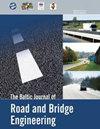无现场传感器的道路温度建模
IF 1.1
4区 工程技术
Q4 ENGINEERING, CIVIL
引用次数: 3
摘要
路面温度的建模有助于冬季道路维护。它用于预测釉料的形成和安排除冰盐水的喷射。通常通过求解能量平衡方程来预测道路天气。它需要设置路面温度的初始垂直剖面,通常从道路天气信息站获得。本文提出使用前七天的平均气温作为地下温度的伪观测。接下来,道路天气模型将以几天的偏移量运行。它首先使用最近的历史天气数据,然后使用可用的预报。这种方法利用了这样一个事实,即能量平衡模型往往会“忘记”其初始条件,并收敛到基线解。实验验证是使用道路环境和温度模型以及华沙道路气象站的数据进行的,为期两年。所提出的伪观测初始化引入的额外预测误差在第一个预测小时内平均为1.2°C,然后随着时间的推移而减小。本文还讨论了使用数字表面模型来考虑阴影效应,阴影效应是城市地区预测误差的重要来源。限制原位传感器的使用为经济、大规模地实施道路气象模型开辟了前景。本文章由计算机程序翻译,如有差异,请以英文原文为准。
Road Temperature Modelling Without In-Situ Sensors
Modelling of the pavement temperature facilitates winter road maintenance. It is used for predicting the glaze formation and for scheduling the spraying of the de-icing brine. The road weather is commonly forecasted by solving the energy balance equations. It requires setting the initial vertical profile of the pavement temperature, which is often obtained from the Road Weather Information Stations. The paper proposes the use of average air temperature from seven preceding days as a pseudo-observation of the subsurface temperature. Next, the road weather model is run with a few days offset. It first uses the recent, historical weather data and then the available forecasts. This approach exploits the fact that the energy balance models tend to “forget” their initial conditions and converge to the baseline solution. The experimental verification was conducted using the Model of the Environment and Temperature of Roads and the data from a road weather station in Warsaw over a period of two years. The additional forecast error introduced by the proposed pseudo-observational initialization averages 1.2 °C in the first prediction hour and then decreases in time. The paper also discusses the use of Digital Surface Models to take into account the shading effects, which are an essential source of forecast errors in urban areas. Limiting the use of in-situ sensors opens a perspective for an economical, large-scale implementation of road meteorological models.
求助全文
通过发布文献求助,成功后即可免费获取论文全文。
去求助
来源期刊
CiteScore
2.10
自引率
9.10%
发文量
25
审稿时长
>12 weeks
期刊介绍:
THE JOURNAL IS DESIGNED FOR PUBLISHING PAPERS CONCERNING THE FOLLOWING AREAS OF RESEARCH:
road and bridge research and design,
road construction materials and technologies,
bridge construction materials and technologies,
road and bridge repair,
road and bridge maintenance,
traffic safety,
road and bridge information technologies,
environmental issues,
road climatology,
low-volume roads,
normative documentation,
quality management and assurance,
road infrastructure and its assessment,
asset management,
road and bridge construction financing,
specialist pre-service and in-service training;

 求助内容:
求助内容: 应助结果提醒方式:
应助结果提醒方式:


